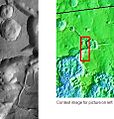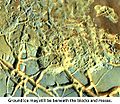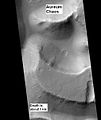- Chaos terrain
-
Chaos terrain (or chaotic terrain) is an astrogeological term used to denote planetary surface areas where features such as ridges, cracks, and plains appear jumbled and enmeshed with one another. Chaos terrain is a notable feature of the planet Mars and Jupiter's moon Europa. In scientific nomenclature, "chaos" is used as a component of proper nouns (e.g., "Aureum Chaos" on Mars).[1]
Contents
Chaos terrain on Mars
Main article: Martian chaos terrain
-
Map of Margaritifer Sinus quadrangle with major features labeled. Aureum Chaos is near the top of the map.
-
Huge canyons in Aureum Chaos, as seen by THEMIS. Gullies are rare at this latitude. Image from Margaritifer Sinus quadrangle.
-
Iani Chaos, as seen by THEMIS. Sand from eroding mesas is covering brighter floor material. Click on image to see relationship of Iani Chaos to other local features. Image from Margaritifer Sinus quadrangle.
-
Quadrangle map of Oxia Palus labeled with major features. This quadrangle contains many collapsed areas of Chaos and many outflow channels (old river valleys).
-
Erosion in Aram Chaos, as seen by THEMIS. Image in Oxia Palus quadrangle.
-
Light colored layers in Eos Chaos, as seen by HiRISE. Image is in Oxia Palus quadrangle.
-
Gorgonum Chaos as seen by Mars Reconnaisance Orbiter HiRISE. Image is 4 km wide. Image in Phaethontis quadrangle.
-
Atlantis Chaos, as seen by HiRISE. Click on image to see mantle covering and possible gullies. The two images are different parts of the original image. They have different scales. Image in Phaethontis quadrangle.
On April 1, 2010, NASA released the first images under the HiWish program in which just plain folk suggested places for HiRISE to photograph. One of the eight locations was Aureum Chaos.[2] The first image below gives a wide view of the area. The next two images are from the HiRISE image.[3]
Causes
The specific causes of chaos terrain are not yet well understood. A number of different astrogeological forces have been offered as causes of chaos terrain. On Europa, impact events and subsequent penetration into a ductile or liquid crust have been suggested.[4]
On Mars chaos terrain is believed to be associated with the release of huge amounts of water. The Chaotic features may have collapsed when water came out of the surface. Martian rivers begin with a Chaos region. A chaotic region can be recognized by a rat's nest of mesas, buttes, and hills, chopped through with valleys which in places look almost patterned. Some parts of this chaotic area have not collapsed completely—they are still formed into large mesas, so they may still contain water ice.[5] Chaotic terrain occurs in numerous locations on Mars, and always gives the strong impression that something abruptly disturbed the ground. Chaos regions formed long ago. By counting craters (more craters in any given area means an older surface) and by studying the valleys' relations with other geological features, scientists have concluded the channels formed 2.0 to 3.8 billion years ago.[6]
In popular culture
- In the graphic novel Watchmen, Dr. Manhattan ponders upon the alternative viewpoints of existence, and says that Mars did not choose life, but rather "chaotic terrain".
References
- ^ Robert Roy Britt, "Chaos on Mars," Space.com
- ^ http://uahirise.org/releases/hiwish-captions.php
- ^ http://hirise.lpl.arizona.edu/ESP_016869_1775
- ^ Ong, Lissa. "Evidence that chaos terrain on Jupiter's moon Europa is formed by crust-penetrating impacts", Geological Society of America Abstracts with Programs, Vol. 36, No. 5, p. 144
- ^ http://themis.asu.edu/features/aramchaos
- ^ http://themis.asu.edu/features/hydraotes
See also
- Arachnoids
- Areas of chaos terrain on Mars
- Astrogeology
- Martian spiders
- Rilles
Categories: -
Wikimedia Foundation. 2010.


















